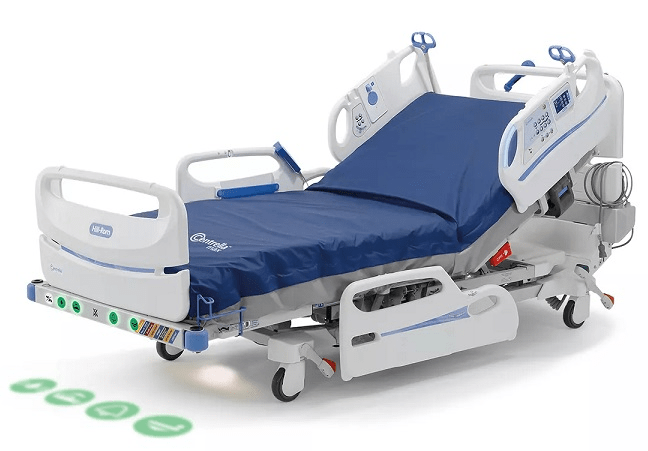Introduction
The future of healthcare is coming sooner than expected. Technology is rapidly transforming the way medical professionals practice medicine and the way patients receive care. By 2024, hospital beds are projected to be completely overhauled with a range of new technologies. From built-in sensors that monitor patient health to virtual reality experiences for entertainment and pain relief, the advances in hospital beds are expected to revolutionize patient care. In this blog post, we will be taking a look at some of the incredible features of the hospital beds of 2024.
A Brief Look at Current Hospital Beds
High-Quality Hospital Beds
When it comes to hospital beds, comfort and functionality are key. Current hospital beds are designed to meet the needs of patients and healthcare providers, but they still have some limitations. Most hospital beds today are adjustable, allowing patients to find a comfortable position and providing support for their bodies. However, these beds often lack smart features and advanced technologies that could greatly enhance the patient experience.
One of the main issues with current hospital beds is the lack of integrated monitoring systems. While patients are often hooked up to various monitors, these are separate devices that can be cumbersome and limit mobility. Additionally, current beds do not have built-in sensors to monitor vital signs and other health indicators, which means healthcare providers must rely on manual checks and assessments.
Another limitation of current hospital beds is the lack of interactive features. Patients often spend long periods of time in bed, and having access to entertainment options can greatly improve their experience. Virtual reality experiences, for example, could provide patients with a form of escapism and help alleviate feelings of boredom and isolation.
The Future of Hospital Bed Technology
The future of hospital bed technology holds immense promise for both patients and healthcare providers. With advancements in technology, we can expect to see high-quality hospital beds that are designed to enhance patient comfort, improve caregiver assistance, and revolutionize medical monitoring and diagnostics.
In the coming years, hospital beds will become more than just a place to rest and heal. They will be equipped with smart features that cater to the unique needs of patients. Imagine a bed that automatically adjusts its position to provide optimal comfort or one that tracks a patient’s vitals and adjusts the room temperature accordingly. These smart features will not only enhance the overall patient experience but also allow healthcare providers to gather real-time data for more accurate diagnoses and treatment plans.
Additionally, robotics and artificial intelligence will play a significant role in the future of hospital bed technology. Bedside robots can assist with patient care, such as lifting and repositioning patients or delivering medications. AI algorithms can analyze patient data and alert healthcare providers to any concerning changes, ensuring prompt and proactive care.
Furthermore, the advancements in medical monitoring and diagnostics will enable hospital beds to serve as comprehensive health monitoring systems. From non-invasive sensors that can detect early signs of infection to advanced imaging capabilities integrated into the bed, these innovations will streamline healthcare delivery and improve patient outcomes.
The future of hospital bed technology also emphasizes sustainability in design. Beds will be made from eco-friendly materials and feature energy-efficient components, reducing their environmental impact.
While these technological advancements in hospital bed design may seem futuristic, they are closer than we think. With the integration of smart features, robotics, AI, and advanced monitoring capabilities, the hospital beds of 2024 will undoubtedly transform the way we deliver and experience healthcare.
Improved Patient Comfort with Smart Features

High-quality hospital beds of the future will prioritize patient comfort through the integration of smart features. Imagine a bed that adjusts automatically to the patient’s preferred position, eliminating the need for manual adjustments. These smart beds will utilize sensors and advanced technology to create a personalized experience tailored to each patient’s needs.
In addition to customizable positions, these beds will offer features like temperature control and ambient lighting. Patients will be able to adjust the room temperature to their preference, creating a soothing and comfortable environment. The lighting can also be adjusted to provide the right level of brightness for relaxation or task-oriented activities.
Another exciting feature of future hospital beds is the integration of built-in massage systems. These systems will offer various massage options, such as shiatsu or deep tissue, to alleviate muscle tension and promote relaxation. This feature will not only enhance patient comfort but also aid in the healing process.
Furthermore, smart beds will incorporate technology to provide enhanced pressure redistribution. Pressure ulcers are a significant concern for bedridden patients, but these beds will utilize advanced materials and sensors to distribute pressure evenly, reducing the risk of ulcers and improving overall comfort.
By prioritizing patient comfort with these smart features, hospital beds of the future will contribute to a better healing environment. Patients will experience personalized care that promotes relaxation, alleviates discomfort, and enhances the overall healing process. The future of hospital beds is indeed promising, revolutionizing the way patients experience healthcare.
Enhanced Caregiver Assistance through Robotics and AI
As we look ahead to the hospital beds of 2024, one of the most exciting advancements we can anticipate is the integration of robotics and artificial intelligence (AI) to provide enhanced caregiver assistance. These technological innovations have the potential to revolutionize the way healthcare providers deliver patient care and support.
Robots are already being used in some healthcare settings to assist with tasks such as lifting and repositioning patients, but the future holds even greater possibilities. Imagine a hospital bed that is equipped with a robotic arm capable of gently moving patients into comfortable positions or providing assistance with daily tasks. This would not only reduce the strain on caregivers but also promote patient independence and dignity.
In addition to physical assistance, AI algorithms can analyze patient data in real-time and alert healthcare providers to any concerning changes. This proactive approach ensures that caregivers can provide prompt and appropriate care, potentially preventing complications and improving patient outcomes.
Furthermore, robots and AI can also play a crucial role in medication management. Smart hospital beds could be equipped with automated medication dispensers, ensuring that patients receive their medications at the correct times and dosages. This would not only reduce the risk of medication errors but also free up healthcare providers’ time to focus on other aspects of patient care.
Overall, the integration of robotics and AI in hospital beds of the future will greatly enhance caregiver assistance. By alleviating some of the physical and administrative burdens, these technological advancements will empower healthcare providers to deliver more efficient and effective care, ultimately improving patient experiences and outcomes. The future of hospital bed technology is truly exciting, and it’s only a matter of time before these advancements become a reality.
Advancements in Medical Monitoring and Diagnostics
Advancements in medical monitoring and diagnostics are set to revolutionize patient care in the hospital beds of 2024. With cutting-edge technology, these beds will become comprehensive health monitoring systems, providing real-time data to healthcare providers for accurate diagnoses and treatment plans.
One of the key advancements in medical monitoring will be the integration of non-invasive sensors into the bed itself. These sensors will be able to detect early signs of infection, monitor vital signs, and track other health indicators without the need for separate devices. This means that healthcare providers can constantly monitor a patient’s condition without interrupting their rest or mobility.
Another exciting development is the integration of advanced imaging capabilities into the bed. Imagine a hospital bed that can perform bedside ultrasounds or X-rays, providing instant diagnostic information to healthcare providers. This will not only speed up the diagnostic process but also reduce the need for patients to be transported to separate imaging facilities, improving their overall comfort and convenience.
Additionally, the future of hospital bed technology will see advancements in remote monitoring and telemedicine. Patients will be able to connect with healthcare providers through integrated communication systems in the bed, allowing for virtual consultations and remote monitoring. This will be especially beneficial for patients who live in remote areas or have limited mobility.
Overall, the advancements in medical monitoring and diagnostics will greatly improve patient care in the hospital beds of 2024. By providing real-time data and diagnostic capabilities at the bedside, healthcare providers will be able to deliver more timely and targeted treatments, resulting in better patient outcomes. The future is indeed bright for medical monitoring and diagnostics in hospital beds.
Sustainability in Hospital Bed Design
As we continue to envision the hospital beds of 2024, sustainability takes center stage in their design. With growing concerns about the environmental impact of healthcare, manufacturers are focusing on creating beds that are eco-friendly and energy-efficient.
In terms of materials, the hospital beds of the future will be made from sustainable and recyclable materials. This means reducing the use of plastics and incorporating more natural materials like bamboo or organic cotton. By opting for environmentally-friendly materials, the carbon footprint of these beds will be significantly reduced.
Another aspect of sustainability in hospital bed design is energy efficiency. These beds will feature advanced energy-saving components that minimize power consumption without compromising on functionality. From LED lighting systems to smart controls that automatically adjust energy usage, these beds will contribute to a greener and more sustainable healthcare environment.
Additionally, the future of hospital bed design will incorporate renewable energy sources. Solar panels or kinetic energy converters may be integrated into the bed, harnessing natural resources to power certain functionalities. This not only reduces reliance on traditional energy sources but also promotes sustainable practices within the healthcare industry.
By prioritizing sustainability in hospital bed design, healthcare providers can not only provide high-quality care but also contribute to a healthier planet. The focus on eco-friendly materials and energy efficiency ensures that the healthcare industry is moving towards a greener future. The hospital beds of 2024 will not only improve patient comfort and care but also contribute to a more sustainable and environmentally-conscious healthcare system.
Cost-effectiveness of New Hospital Beds
When discussing the future of hospital beds, it’s important to consider the cost-effectiveness of these new technologies. While the advancements in hospital bed technology are exciting and promising, it’s crucial to assess their financial feasibility and potential return on investment.
The good news is that the cost-effectiveness of new hospital beds is expected to be a major consideration in their design. Manufacturers understand that healthcare institutions operate on tight budgets and need to prioritize cost-efficient solutions. As a result, the beds of 2024 are being designed with affordability in mind.
One way this is being achieved is through modular designs. These beds can be customized and upgraded as needed, reducing the need for frequent replacements and minimizing long-term costs. Additionally, manufacturers are focusing on optimizing the lifespan of these beds to ensure they can withstand heavy usage and provide value for money over time.
Moreover, the integration of smart features and advanced monitoring capabilities in hospital beds is expected to result in cost savings. By enabling healthcare providers to gather real-time data and make more accurate diagnoses, these beds can help prevent complications and reduce the length of hospital stays.
While the upfront investment in these high-tech beds may be higher, the long-term cost savings and improved patient care justify the expense. Ultimately, the cost-effectiveness of new hospital beds lies in their ability to enhance patient outcomes, improve efficiency, and streamline healthcare delivery. The future of hospital beds is indeed bright, not only in terms of technological advancements but also in terms of their financial feasibility.
Author Bio
James Anderson is a Marketing Consultant & Content Writer with 4 years of experience in B2B Marketing. Currently, he heads the marketing strategy department at AverickMedia, a renowned B2B data solution company based out of Houston, Texas.
*****





























